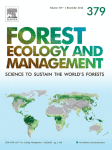Ver ítem
- xmlui.general.dspace_homeCentros Regionales y EEAsCentro Regional Patagonia NorteEEA BarilocheArtículos científicosxmlui.ArtifactBrowser.ItemViewer.trail
- Inicio
- Centros Regionales y EEAs
- Centro Regional Patagonia Norte
- EEA Bariloche
- Artículos científicos
- Ver ítem
Assessment of resistance to xylem cavitation in cordilleran cypress using near-infrared spectroscopy
Resumen
Characterizing drought resistance of forest trees is an important aim in the worldwide context of increasing forest decline and dieback. Furthermore, wood demand is increasing all around the world, urging the need for the domestication of native species and the selection of the most resistant individuals. While near-infrared spectroscopy is now recognized as an efficient tool to predict wood physical and chemical properties involves in wood quality, its
[ver mas...]
Characterizing drought resistance of forest trees is an important aim in the worldwide context of increasing forest decline and dieback. Furthermore, wood demand is increasing all around the world, urging the need for the domestication of native species and the selection of the most resistant individuals. While near-infrared spectroscopy is now recognized as an efficient tool to predict wood physical and chemical properties involves in wood quality, its ability to predict wood hydraulic function remains anecdotic, although it has recently gained interest. In this study, we tested near-infrared spectroscopy as a high-throughput method for quantifying both
resistance to cavitation and basic wood density in the South American conifer Austrocedrus chilensis. Models were obtained in two laboratories using the same sample set. To assess resistance to cavitation, vulnerability curves were obtained using the air-injection method. Basic wood density was measured in the same samples as used for resistance to cavitation. Partial least squares regression models with cross-validation were used to establish relationships between the NIRS spectra and wood traits. The accuracy of the models strongly depended on the traits being used for calibration. Models obtained in both laboratories were similar, demonstrating the genericity of the approach whatever equipment used. Promising results were obtained for two cavitation parameters (water
potential at 12% and 50% of hydraulic conductivity loss) and basic wood density. Prediction errors for these traits were low. In contrast to studies at the interspecific level, basic wood density and resistance to cavitation were negatively correlated at the intraspecific level in the studied species, but our calibration models shown than basic wood density cannot be used as a good predictor of functional traits. The NIRS has high potential to be put into practice as a rapid, reliable, and non-destructive method to determine, resistance to xylem cavitation, a trait involved in drought resistance.
[Cerrar]

Autor
Sergent, Anne Sophie;
Segura, Vincent;
Charpentier, Jean-Paul;
Dalla Salda, Guillermina;
Fernandez, María Elena;
Rozenberg, Philippe;
Martinez Meier, Alejandro;
Fuente
Forest ecology and management 462 : 117943. (2020)
Fecha
2020-04
Editorial
Elsevier
ISSN
0378-1127
Formato
pdf
Tipo de documento
artículo
Palabras Claves
Derechos de acceso
Restringido
 Excepto donde se diga explicitamente, este item se publica bajo la siguiente descripción: Creative Commons Attribution-NonCommercial-ShareAlike 2.5 Unported (CC BY-NC-SA 2.5)
Excepto donde se diga explicitamente, este item se publica bajo la siguiente descripción: Creative Commons Attribution-NonCommercial-ShareAlike 2.5 Unported (CC BY-NC-SA 2.5)

